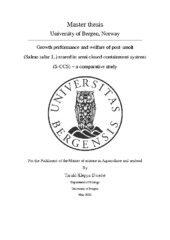Growth performance and welfare of post-smolt (Salmo salar L.) reared in semi closed containment systems (S-CCS) – a comparative study
Master thesis
Permanent lenke
https://hdl.handle.net/1956/22858Utgivelsesdato
2020-06-23Metadata
Vis full innførselSamlinger
- Master theses [257]
Sammendrag
The salmon industry faces challenges related to sea lice infestations, escapees, diseases and environmental impact. Semi closed containment systems (S-CCS) have been proposed to abate these challenges. In the S-CCS, cultured fish are separated from the natural environment by a physical barrier. The use of these systems reduces the time fish spend living in open sea cages. This study investigated and documented welfare and growth performance of Atlantic salmon through an acute challenge test experiment and a big-scale benchmark study. The acute challenge test experiment was conducted using post-smolts raised in two large scale semi-closed system (S-CCS: Preline and Neptune), with reference groups raised in open sea cages. The post-smolt was stressed by confining them in a holding tank with reduced water level for a short period. Corresponding baseline sampling was done on unstressed fish for comparable measurements. For the benchmark study, selected production data from six generations of salmon was used to compare growth and performance of fish raised in S-CCS (Preline) and in open sea cages (reference). The benchmark study was carried out in two phases. Phase one used post-smolts from approximately 100 g to 800 g in seawater, and fish in S-CCS were compared with a reference group from an open sea cage. The second, grow-out phase used salmon from approximately 800 g to 5000 g in open sea cages; here fish previously reared in S-CCS were compared with fish from a reference group. Fish raised in the S-CCS showed lower concentration of plasma cortisol, magnesium and lactic acid at baseline levels, giving a stronger response to the acute stress challenge than fish from the reference group. The results suggest lower basal stress in the S-CCS group compared with the reference group in open sea cages, as well as a more balanced response to stress in the S-CCS fish. The findings from the benchmark analyses showed a significantly lower infestation of sea lice in Preline fish during the post-smolt phase. Furthermore, in the grow-out phase the Preline group showed higher weight gain and higher final weight compared to the reference group in open pen (Weight at harvest: Spring transfer, Preline=4.65 kg vs reference group=3.79 kg, Fall transfer, Preline=4.87 kg vs reference group=4.03 kg). Finally, salmon raised in Preline showed significantly higher survival compared to the reference group, indicating increased robustness in fish raised in S-CCS when transferred to open net pens in sea. As the results indicate reduced stress, lower sea lice infestations and greater weight gain, S-CCS appears to have advantages compared to traditional long exposure to the natural environment in open sea cages in Norway. However, to determine the real potential of S-CCS strategy, further research is needed.
